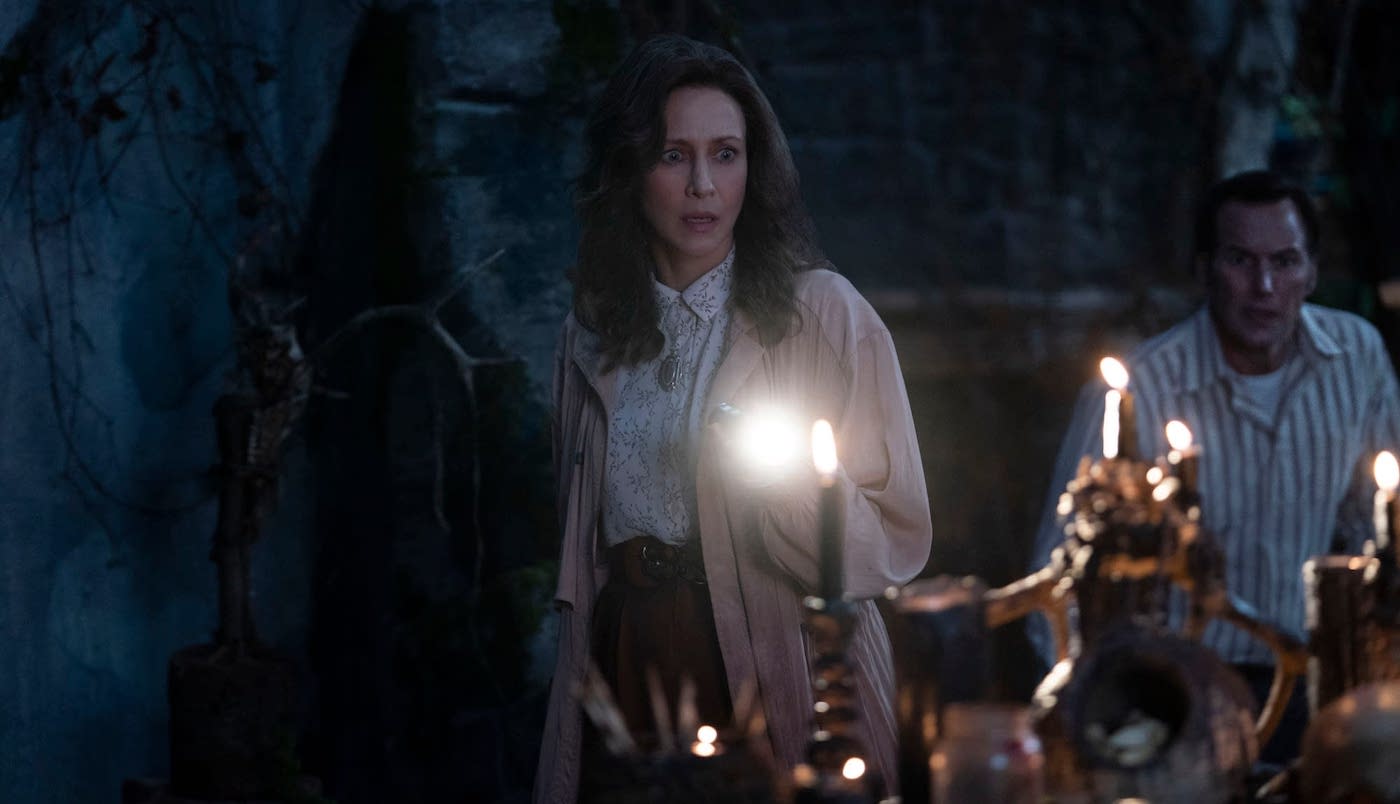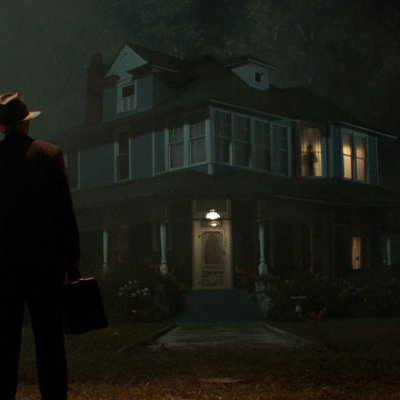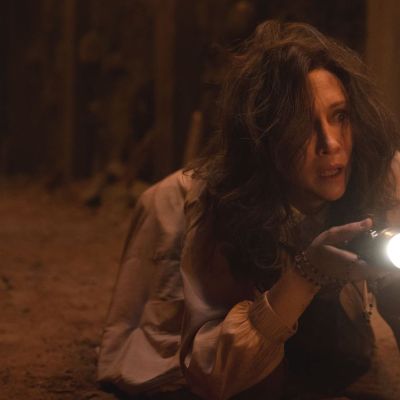This article features The Conjuring: The Devil Made Me Do It spoilers. The piece also contains information regarding violence and abuse that may upset some readers.
Director Michael Chaves and company are not subtle about their influences in The Conjuring: The Devil Made Me Do It. It’s there in the first scene. As we’re reintroduced to Ed and Lorraine Warren, darkness has fallen over a family, and a Satanic presence is in the home. A young child lays bedridden, cursed to endure demonic possession, and an old priest arrives late in the foggy night. When Father Gordon gets out of his cab, The Conjuring even reenacts an image so famously associated with The Exorcist that Warner Bros. made it that movie’s poster almost 50 years ago.
But maybe it’s a good thing The Conjuring flicks are getting blunter about who they’re borrowing from. The earlier movies in the series regularly evoked William Friedkin’s 1973 exorcism movie, including with their 1970s settings. But we’re past those small winks and nudges in The Devil Made Me Do It. The threequel has moved on to 1981 and away from worrying only about demons. Aye, we now must also dread the occultists and cults who summon them. And at a glance, it’s kind of fun that the series is playing with the heightened religious paranoia of the Reagan era.
If the original The Conjuring was set during a golden age for religious horror movies, then The Conjuring 3 continues Ed and Lorraine’s thread at the moment when that fear of Satanists became more than fiction to millions of Americans. Within two years of The Devil Made Me Do It’s setting, a rising tide of Satanic Panic would lead to dozens of school officials, employees, and parents being accused of participating in Satanic rituals which included blood orgies and human sacrifices—with many serving years or decades in prison. It was the beginning of a new kind of paranoia in American life, and it was inspired, at least in part, by the spooky imagery of movies like The Exorcist.
Friedkin’s original “the Devil made me do it” chiller was not the first big Hollywood movie about the danger of demonic activity in 20th century America, but it was the most popular. Released the day after Christmas in 1973, The Exorcist became a pop culture phenomenon, the likes of which the horror genre has rarely seen before or since. When adjusted for inflation, it sold more tickets than Avatar, Titanic, or any film in the Marvel Cinematic Universe. With an almost clinical documentarian disaffection, the movie’s shock horror scared the hell out of audiences, leading to a massive surge in church attendance. Not that all church leaders were receptive. In fact, evangelist Billy Graham famously alleged the film itself was evil, saying “the Devil is in every frame.” Apparently, the celluloid prints were all individually cursed. (One can only imagine what Graham would’ve made of the streaming service Shudder.)
But that is perhaps the real key to the rising fear of Satan in the ‘70s and ‘80s. Films like The Exorcist were just a snapshot of a culture in the midst of ideological upheaval. There was the increased secularization that came from younger generations demanding more than their parents’ hegemonic status quo, but there was also a simultaneous revival of evangelism and modern Christian fundamentalism, which was in part a reaction to that same rapid change.
Movies like Exorcist tapped into the zeitgeist, and maybe shaped it, slightly, but those forces were already there. At most, something like Friedkin’s film just gave anxiety among religious Americans a new image of what that indescribable fear looks like. For example, thanks to The Exorcist, the Ouija board went from a harmless child’s game to being viewed in some households as the gateway to Hell forevermore.
And beyond horror films, there was a growing (and more grounded) fear of cults in this period. That’s because in August 1969, followers of Charles Manson broke into the homes of Sharon Tate and Leno and Rosemary LaBianca over the course of two nights, murdering seven people between them, including Tate’s unborn child (she was eight and a half months pregnant).
The murders were committed in a ritualistic, grisly fashion that included messages written in blood on the walls. Meanwhile, Tate’s husband and the father of her child, Roman Polanski, had recently directed the first major Hollywood blockbuster about Satanic cults, Rosemary’s Baby (1968), in which a pregnant woman is offered up to the Dark One. The grim parallels did not go unnoticed in the seedier corners of the press before the “Manson Family” was finally arrested in December of that year.
The culture-shattering effects of the Manson murders are still being felt 50 years later as major movies continued to be made on the subject. Even The Conjuring films have tapped into it, with the original Annabelle spinoff in 2014 being set in 1967, the same year that the novel Rosemary’s Baby was published. That movie revealed the Annabelle doll was commandeered by a demon controlling a Manson-like cult called the Disciples of the Ram, which were responsible for a random home invasion that ended in ritualistic slaughter. The Disciples of the Ram is also the cult name-dropped in The Conjuring: The Devil Made Me Do It. Additionally, the central characters in Annabelle are named Mia and John, after Mia Farrow and John Cassavetes, who played a married couple introduced to a cult of witches in Polanski’s Rosemary’s Baby.
By the time 1980 rolled around, movies like Rosemary’s Baby, The Exorcist, and their slew of copycats were slowly turning into a mirror—not so much of reality but of what many folks feared to be the rising menace of cults and occult-inspired crime. It was the era of a “silent majority” rejecting counterculture and its various eccentricities, including the rise of actual Satanism as a government-recognized religion.
Indeed, Anton LaVey founded the Church of Satan and wrote The Satanic Bible in 1966, which despite its provocative title and imagery was largely a derivative philosophical text about self-actualization. Some have even convincingly argued that LaVey simply pilfered then-obscure 19th century philosophers and added an occult gloss to get attention and tax exempt status for his new venture. It also was a hell of a way to troll devout Christians.
If provocation was the goal, the Church of Satan got its wish, contributing to a conservative rejection of leftist counterculture, particularly following media obsessions with ritualistic serial killers like the Zodiac Killer in northern California, or the Jonestown cult, which committed ritualistic mass murder and suicide by the hundreds in 1978, all in the purported name of socialism. Meanwhile, evangelist Jerry Falwell Sr. was founding the “Moral Majority” in 1979 as a political movement designed to elect Republicans based, in part, out of a fear of the secularization of American society.
By the 1980s, millions of Americans were primed to believe that the Devil, or at least his nutso disciples, walked among us like the friendly neighbors in Rosemary’s Baby, all while secretly waiting to serve you up to Beelzebub. Consider the villain in The Conjuring: The Devil Made Me Do It, a mysterious woman who damns a child to possession simply because… she can? In a world where Satanic cults and human sacrifices are real, motives are incidental.
This largely fanciful fear manifested itself into a more gruesome reality when soon-to-be-disgraced Canadian psychiatrist Lawrence Pazder and his wife Michelle Smith published the now thoroughly debunked Michelle Remembers in 1980. As a discredited memoir by a doctor and patient who later married, the book became a bestseller with its sensationalistic and lurid tales derived from Smith’s “memories” attained via controversial Recovered Memory Therapy (hypnosis).
In the book, Smith and her doctor/husband claimed that while in a trance she remembered her mother was secretly a member of the Church of Satan. However, this wasn’t the glorified far-left contrarian organization founded by LaVey in 1966. According to Michelle Remembers, the Church of Satan actually predates the founding of the Roman Catholic Church 2,000 years ago, and it’s acted for centuries as a secret organization trading in the blood of slaughtered infants (QAnon followers would love it).
Smith claimed that in the 1950s, when she was between the ages of five and six, she was kept in cages, tortured, sexually abused, and participated in rituals that included orgies, human sacrifices, and on one occasion summoning Satan himself from the bowels of Hell. Smith also claimed she was saved and had her physical scars erased by no less than a returned Jesus Christ and the Virgin Mary. The book was a publishing sensation, and even by 1989, Smith was still showing up on Oprah Winfrey’s talk show to chat about the danger of Satanic cults. Winfrey booked her alongside Laurel Rose Willson, a woman who falsely claimed she was raised by Satanists to be a “breeder,” pumping out infants for human sacrifice and dismemberment.
Two years after Michelle Remembers was published, social workers in Bakersfield, California, who had read the book, became concerned when two children (who were coached by their step-grandmother) claimed they were sexually abused by their parents—claiming their family was part of a secret cult. No evidence was found, but faster than you can say Salem, more children were encouraged to come forward and offer similar tales of abuse and Satanic activity. Ed Jagels, the district attorney and local conservative culture warrior, had his office tell jurors that more than 30 people participated in a Satanic cult that drank blood, murdered infants, and participated in incest.
Twenty-six people were convicted of sexual abuse without corroborating evidence. Twenty-five of those cases were overturned by Californian appellate courts, although not before one innocent man served 20 years out of his 40-year sentence. Children later admitted they made up incidents and were guided by concerned interviewers, and Kern County was forced to settle $9.56 million in lawsuits from those wrongfully accused and convicted.
This was only the first in a string of high-profile 1980s cases dubbed by the press to be “daycare sex abuse hysteria.” They also acted as a grotesque subgenre of a then thriving Satanic Panic. Just a year after the Bakersfield accusations began, a mother who was later diagnosed with acute paranoid schizophrenia accused the staff of the McMartin preschool in 1983 of conspiring with her estranged husband in the rape of her son. The child then told investigators that he witnessed a sex cult in his preschool, which included witchcraft and a teacher levitating before flying around the room.
Local police investigators welcomed the help of an unlicensed psychotherapist to examine 400 children in the school. The results led to seven daycare staff members being accused by 41 children of 321 counts of child abuse, which included stories of hidden underground tunnels, sex orgies, and at least one baby being sacrificed to Satan. The resulting five-year trial and legal proceedings remains the most expensive in California’s history, in which no physical evidence was presented and there were no convictions. But Winfrey guest Laurel Rose Willson testified as a witness, claiming she saw the abuse firsthand during her time as a Satanist.
These were just a handful of cases, and the first of at least a half-dozen daycare centers accused of Satanic activity and abuse. Several led to wrongful convictions of preschool owners and teachers. The convictions were overturned years later. However, the terror of baby-sacrificing Satanists walking among us persisted.
In 1982, Patricia Pulling began a well-publicized campaign against Dungeons & Dragons after her son died by suicide. Pulling, and soon many sympathetic evangelicals, became convinced the roleplaying game drove him to suicide due to cursed cards with demonic power. Future Fox News mainstay Geraldo Rivera hosted Devil Worship: Exposing Satan’s Underground on NBC in 1988, which became the highest-rated television documentary up to that point. In 1992, the Justice Department was forced to publish a monograph thoroughly explaining why American law enforcement needed to stop considering “Satanic cults” as a threat to society.
And as late as 1994, three teenagers in West Memphis, Arkansas were famously convicted of murdering three boys the year before based largely on hearsay evidence and the prosecution accepting rumors that these goth teenagers worshipped the Devil. Therefore the 1993 murders were part of a “Satanic ritual.” In 2007, forensic evidence revealed the only DNA found at the crime scene belonged to the victims and unknown killers who were not the West Memphis Three. They were released after serving 18 years in prison, although to this day Arkansas has failed to expunge their convictions.
Read more
The Conjuring: The Devil Made Me Do It is (very) loosely based on a court case during this era of mass Satanic hysteria. A cynic might even wonder if the real Ed and Lorraine Warren pitched the “Devil made me do it” defense to tap into the then prevalent fear of little possessed Regan MacNeils spider-walking down the stairs at any moment. While the real Ed and Lorraine were never asked to participate in the investigation of a missing person who turned out to have died by demon-induced suicide (as seen in the movie), there were plenty of police detectives in the ‘80s ready to embrace a fear of the occult as both motive and Exhibit A evidence.
Perhaps that’s why there is a slightly ickier feeling about The Conjuring 3 than its predecessors. The new movie plays into a cultural fantasy that ruined lives and sent innocent people to prison. There’s a scene in The Devil Made Me Do It where the saintly onscreen versions of Ed and Lorraine Warren take text written by medieval Catholic Church witch hunters as gospel—which is a disquieting notion when one pauses to consider the likely superstitious and misogynistic motivations of those torch-happy holy men.
It also would be too easy to smirk now at the madness of heartland Christians convinced their neighbors were baby-eaters 40 years ago. That type of paranoia still exists in modern conspiracy theories, even if it is slightly less tied to fears of demons and exorcisms. Ask the owner of a pizza parlor in Washington D.C., which right-leaning conspiracy theorists were convinced housed a child sex ring, resulting in a man storming into the restaurant with a gun.
Meanwhile, a poll in 2020 found that as many as 53 percent of self-identified Republicans believed the QAnon conspiracy theory which claims Democratic leaders and Hollywood celebrities drink the blood of children to stay young. Witches, vampires, and even the Devil can be the source for fascinating stories and fictions. But when folks believe in this stuff, it’s far too easy to become possessed by a more human evil.


